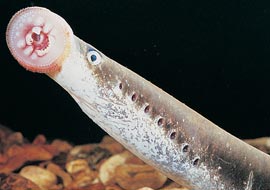Sharks, Lampreys & Rays
What are sharks?

Sharks, which comprise only about 1 percent of all living fishes, are highly evolved representatives of a large and unique group of fishes - the cartilaginous fishes, or class Chondrichthyes.
Sharks are jawed fishes. Like all fishes they are aquatic, water-breathing vertebrates with a brain and spinal cord; fins; plate-like pairs of internal gills; and paired sense organs.
Unlike most bony fishes, sharks do not have swim bladders or lungs. Sharks' jaws are simple but effective structures, armed with transverse rows of hard teeth that are replaced slowly but continuously. These teeth are not in sockets, but attached to the jaws by soft tissue.
All sharks have paired fins - pectoral and pelvic - on the underside of the body. The pectoral, or breast, fins are located just behind the gill region of the head. The pelvic fins are on the rear of the abdomen just in front of the tail. Most sharks have a cylindrical or slightly depressed head and body; a strong tail with caudal, or tail, fin; one or two dorsal fins on their back; and an anal fin on the underside of the tail behind the vent.
Also see Great white sharks.
What are lampreys?

Lampreys belong to the class Cephalaspidomorphi, and are found in marine and freshwater environments. They relatively have an eel-like appearance.
Lampreys feed by attaching on other fishes. It will fasten its tooth- filled mouth onto its prey and rips out a hole with its rough tongue and with their suctorial mouths will extract blood and other body fluids from the fish. Each sea lamprey can kill as much as 18 kilograms of fish during the 12-20 months of its adult life. They usually feed on large fishes such as trouts.
A special chemical in the sea lamprey's saliva keeps the wound in the fish open until the fish dies. The saliva from the sea lamprey can keep the wound open for hours or weeks. Only 1 out of 7 fish attacked by a sea lamprey will survive.
The sea lamprey is native to the Atlantic Ocean, and because the Great Lakes are connected to the Atlantic, they have become a nonnative species in the Great Lakes. Since the sea lamprey came to the Great Lakes, some native fish species are in danger of dying out, such as the lake trout.
What are rays?

No ray can kill humans, but the stingray can inflict a painful sting. They have spines on their tail which can poison other animals when stung. Some rays have long, whip-like tails, other species have short tails. Some rays have a series of thorns on their body as a defense against predators.
The smallest ray is the Short-nose electric ray, which is the size of a pancake; it is only 4 inches (10 cm) across and weighs about 1 pound (0.5 kg). The biggest ray is the manta ray which is over 22 feet (6.7 m) wide and weighs many tons (thousands of pounds).